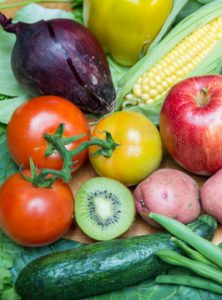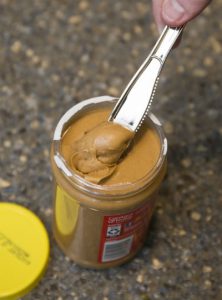Hurricane Season runs from June 1 through November 30. We have seen the devastating effects to communities that have been hit hard by hurricanes, which are always a very real threat to Florida. Preparedness is one key to successfully weathering these types of storms.

Stocking your pantry, creating a food shopping list centered around healthy menu ideas, planning for food storage, and food safety and cleanup are all important steps in the planning process.
Many people do not really think about meal planning and just purchase random food supplies. It is a good idea to have a specific shopping list in hand when you go to the store. Think about nutrition when you assemble your shopping list and plan your purchases. Good nutrition includes a well-balanced diet that includes a variety of foods from each of the food groups: proteins, fruits, vegetables, grains, and dairy products. Healthy eating can be easy and fun, but it should also include food choices that provide plenty of vitamins and minerals.

Last-minute shopping often finds consumers confronted with empty shelves and limited food options. Prepare in advance so you will not face shortages at the grocery store.
It is even more important to shop in advance during COVID-19 so you can avoid the crowds. This will reduce your exposure to the virus and will allow you to more easily engage in social distancing. This will also spread the cost of needed items over a longer period of time.
The following questions and answers outline what Broward’s citizens need to know to prepare healthy and well-balanced meals during emergencies, including hurricanes.
What is a food and nutrition disaster supply kit?
A food-and-nutrition disaster-supply kit is a collection of basic items your household may need in the event of an emergency. For food supplies, your “kit” will be bigger than, say, a first-aid kit. Many households keep their supplies in a large plastic storage bin, a large cardboard box, reusable grocery bags, or large plastic garbage-type bags. It is a good idea to keep whatever type storage container you choose sealed. Be mindful of expiration dates on food items, too.
Why do you need to keep a small supply of food items on hand?
After an emergency, you may need to survive on your own for several days. Being prepared means having your own food, water, and other food-related supplies to last for at least 72 hours. Registered and licensed dietitians recommend that consumers think about nutrition when making hurricane preparedness plans and shopping lists. Most people report that they shop the day before the storm, with many buying mainly granola bars, cookies, loaves of bread, jars of peanut butter, and potato chips as staples. After a few days of eating these types of foods, however, many people will feel deprived and crave a solid, heated meal rather than just snacks. A certain amount of stress food is okay, but try to focus on foods that allow you to create planned, balanced meals. Another problem worth mentioning is that people who are experiencing pre-storm anxiety often eat their disaster supplies before the storm even gets there. Do not dip into your food supplies until they are needed.

Will you have electricity?
Following a disaster there may be power outages that could last for several days or more. Individuals need to stock canned foods and other staples that do not require refrigeration, cooking, water, or special preparation. Meals ready-to-eat (MRE’s) are often distributed, in advance, to seniors and are a good idea for others as well. If you use a grill, use it safely outside.
Will there be safe running water for drinking and cooking?
Listen to local authorities as to whether a boil-water order is in effect. Make sure you monitor for safe water at the beginning of the storm and continue throughout disaster recovery.

Where should I begin?
When a storm is imminent, you may wonder how you can think about nutrition at a time like this? Staying focused and engaging in advanced planning is the key.
Learn how to best assemble an emergency food supply kit suited to your and/or your family’s likes and tastes. Each person should plan for a two-week supply of nonperishable packaged or canned food, as well as juices, that require little or no cooking and no refrigeration. Include healthy snacks and any specific foods required by infants, the elderly, or people with special dietary needs.
Keep planned written menus that have worked for you and your family inside your hurricane food-supply kit in a zip-type plastic bag. These can be reused from year to year as long as they close securely.
The cooking and cleaning supplies that go along with your food preparation are important as well. Remember that you are trying to cover the meal content and the safety and cleanliness of preparing meals during a disaster, too.
The following ideas may help you plan daily three-meal menus and include healthy snacks throughout the day.
Be sure to include balanced nutrition
in your planning.
Choose MyPlate- https://www.choosemyplate.gov/

SHOPPING LIST – Suggested Pantry Items
Consider adding items such as these, from each of the MyPlate food groups, to your shopping list when stocking up on pantry items and filling hurricane food-supply kits.
• Ready-to-eat canned or prepackaged meats, tuna, chicken, fruits, vegetables
• Canned soups
• Canned chili
• Canned ravioli, spaghetti
• Dried fruit
• Jerky
• Protein or fruit bars
• Peanut butter
• Dried beans
• Pasta/rice
• Dry ready-to-eat cereal, oats, or granola
• Bread
• Dinner rolls
• Red sauce, other favorite sauces
• Jam/jelly
• Nonperishable pasteurized milk
• Cookies
• Graham crackers
• Animal crackers
• Vanilla wafers
• Nuts and seeds
• Trail mix
• Cooking oil, cooking spray
• Condiments
• Coffee, tea, cocoa
• Canned or bottled juices
• Bottled water
• Aluminum foil
• Parchment paper
• Paper plates and bowls
• Disposable eating utensils
• Disposable aluminum pans
• Zip-type storage bags
• Dish soap
• Hand sanitizer
• Kitchen gloves
• Trash bags
Broward Extension Hurricane Preparedness YouTube video –https://youtu.be/wnbxmDF6FOI
THE FOOD GROUPS
Consider adding foods from each of the five food groups to your disaster kit and then incorporate them into meals. Low-sodium, low-fat, and/or whole grain versions are offered for many of these items listed and should be considered.
Bread Group
Breakfast cereal • crackers • breakfast/nutrition bars • rice cakes • whole-wheat or multigrain bread • dry pasta • Boston brown bread with raisins • melba toast • taco shells • chips • vanilla wafers • bread sticks • muffins • graham crackers • pretzels • purchase just before storm: fresh bread, round flatbread for wraps
Vegetable Group
Canned vegetables and soups • canned three-bean salad • mushrooms • salsa • spaghetti sauce • purchase just before storm: fresh carrots, broccoli, etc.
Fruit Group
Canned fruit in their own juices • dried fruit • 100% fruit juice • trail mix with fruit • fruit cocktail • unsweetened applesauce • packaged: raisins, apricots, cranberries, etc.
Milk Group
Nonfat milk (powdered, canned, or shelf-stable) • shelf-stable puddings • nutritional drinks • cheese spread
Meat Group
Meat soups • peanut butter • bean spreads • packaged nuts (unsalted, dry roasted, peanuts, walnuts, almonds, etc.) • beef or turkey jerky • Vienna sausage • canned: tuna, ham, salmon, sardines, chili, corned-beef hash, ravioli, beans (kidney, lima, black-eyed peas, lentils, etc.)
Note: Just before the storm, buy bread, fresh broccoli, tomatoes, apples, and other fruits and vegetables that do not require refrigeration.
Extras
Bottled water • Gatorade • instant iced tea • instant coffee • tea bags • powdered drink mixes • jelly • small packets of ketchup, mustard, and mayonnaise • granola bars • fruit and nut bars • infant food • formula • food for special diets
Other Items
Manual can opener • disinfectant wipes • three face masks per person • Sterno • fondue pot • portable stove with fuel
SAMPLE MENUS/ MENU PLANNING
Consider meals such as these, keeping in mind that everyone has different likes and dislikes. Choose the healthiest options, when available.
Breakfast Ideas
Apple juice • ready-to-eat cereal • small boxes of raisins • breakfast bars with fruit • shelf-stable skim milk • tea or instant coffee • water
Orange juice • hot cereal/instant oatmeal • banana • muffin • shelf-stable skim milk • tea or instant coffee • water
Grape juice • ready-to-eat cereal • canned peaches • yogurt • bread with jam or jelly • shelf-stable skim milk • tea or instant coffee • water
Lunch Options
Chunky beef soup (ready-to-eat style that only needs heating) • crackers • carrot and celery sticks • nuts • fruit cups packed in water • vanilla wafers • shelf-stable skim milk • tea or instant coffee • water
Canned cream soup (ready-to-eat style that only needs heating) • tuna sandwich on whole-wheat bread • tomato slices • unsweetened applesauce • cookies • shelf-stable skim milk • tea or instant coffee • water
Canned chili with beans (ready-to-eat style that only needs heating) • dinner rolls with margarine or butter • broccoli florets • canned fruit • animal crackers • shelf-stable skim milk • tea or instant coffee • water
Dinner Suggestions
Canned meat or cheese ravioli • three-bean salad (canned) • fresh yellow apples • bread with margarine or butter • fat-free pudding cup • shelf-stable skim milk • tea or instant coffee • water
Egg-salad sandwich on whole-wheat bread • canned green beans • canned fruit • fat-free pudding cup • shelf-stable skim milk • tea or instant coffee • water
Mac and cheese • canned vegetable • fresh pears • dinner rolls with margarine or butter • cookies • shelf-stable skim milk • tea or instant coffee • water
FOOD SAFETY
Remember basic handwashing for 20 seconds with soap and water is always recommended. Be sure to follow the basic food-safety principles: cook, clean, chill, and separate. Sanitize cooking and food preparation surfaces often.
Food safety- https://www.fightbac.org/
Without power, electricity, or a cold source to store food in refrigerators and/or freezers, food can become unsafe. Bacteria in food grow rapidly at temperatures between 40° F to 140° F, and if contaminated foods are consumed you can become very sick.
Use a thermometer to test internal food temperatures. Store food in covered containers. Make sure to keep cooking and eating utensils and outdoor stoves and grills clean. Throw away any food that has come in contact with contaminated flood water. Toss out food that has been at room temperature for more than two hours or any food that has an unusual odor, color, or texture. Do not eat foods from cans that are dented, swollen, or corroded, even though the product may look safe to eat. Check expiration dates.
Remember: “When in doubt, throw it out.”
Recap
Will you be ready to feed yourself and/or your family nutritiously when storms or other natural disasters occur? Be prepared. Hurricane preparedness matters to us all. As we say in Broward County: Be ready. Be set. Be safe.
UF/IFAS Extension, Broward County, Family and Consumer Sciences provides the science for better living.
For more information
1. UF/IFAS Broward Website, Family and Consumer Sciences – http://sfyl.ifas.ufl.edu/broward/family-and-consumer-sciences/
2. UF/IFAS Broward Extension Blogs – https://blogs.ifas.ufl.edu/browardco/
3. Preparing and Storing an Emergency Safe Drinking Water Supply – http://edis.ifas.ufl.edu/pdffiles/SS/SS43900.pdf
4. Safe handling of food and water in a hurricane or related disaster –http://edis.ifas.ufl.edu/pdffiles/FS/FS13100.pdf
 0
0
